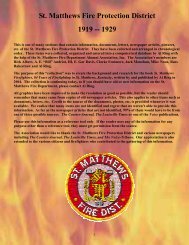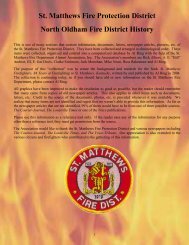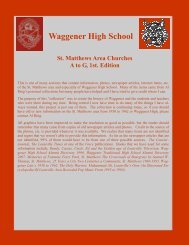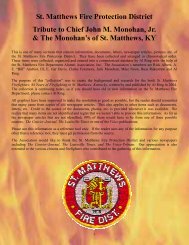St. Matthews Fire Protection District 1983 - RingBrothersHistory.com
St. Matthews Fire Protection District 1983 - RingBrothersHistory.com
St. Matthews Fire Protection District 1983 - RingBrothersHistory.com
Create successful ePaper yourself
Turn your PDF publications into a flip-book with our unique Google optimized e-Paper software.
Section 4<br />
112<br />
112<br />
<strong>1983</strong><br />
<strong>1983</strong>: A Brief History of Jefferson County <strong>Fire</strong> <strong>Protection</strong> <strong>District</strong> 26. --- Written in <strong>1983</strong>.<br />
The <strong>St</strong>. <strong>Matthews</strong> Volunteer <strong>Fire</strong> Association was formed as a nonprofit organization chartered in the Commonwealth<br />
of Kentucky and governed by a board of directors. “<strong>St</strong>. <strong>Matthews</strong> citizens form fire brigade” was the<br />
caption over an article in the Courier—Journal on June 13, 1919. It went on to say “For the purpose of fire<br />
protection of the houses in and around <strong>St</strong>. <strong>Matthews</strong>, residents of that town have formed a fire brigade.” It<br />
started with a handful of dedicated men, no money, and an old hand pulled hose cart. These pioneers, being the<br />
first of their kind in the Commonwealth, had no where to turn and thus had to do it all on their own.<br />
The first fire chief, Xavier Schuler, made arrangements with A. J. Eline to house the hose cart in his automobile<br />
dealership on Frankfort Avenue. There was, at that time, only one fire hydrant at the intersection of Lexington<br />
Road and Frankfort Avenue. With very little money and no experience, it was a wonder that the fire department<br />
survived.<br />
In 1921 Andrew Neichter became fire chief. The department bought a Model “T” Ford truck for $900. The<br />
firefighters mounted three chemical tanks and a wooden ladder on it, and now had their first real fire engine. In<br />
1923 they were given a piece of land behind the drug store at Breckinridge Lane and Frankfort Avenue upon<br />
which the department built its first firehouse. Along with providing fire protection, the fire insurance rates<br />
wore reduced.<br />
By 1930, the department was in real trouble with the <strong>St</strong>ate Actuary Bureau. The town was told to get a new fire<br />
engine or lose its insurance classification. Because of this, the board of directors reorganized in 1930 and started<br />
on an active plan to buy a new fire engine. In 1931 a 500 G.P.M. Seagrave pumper was delivered to the department<br />
and given the name Betsy. The departments financial troubles were still prevalent and for several<br />
years they had to hide “Betsy” from the Seagrave Company to keep it from being repossessed.<br />
“Betsy” became the pride of the <strong>com</strong>munity , making all of the town’s parades and hundreds of fire runs each<br />
year, even going as far as Frankfort to help with the penitentiary fire It was used to pump out many basements<br />
during the 1937 food. Although “Betsy” was retired from fire response in December of 1973 after 42 years of<br />
service, she is still owned by the department and still runs.<br />
By 1939, the department’s emergency runs were increasing~ A good percentage of them were outside of the<br />
fire protection area. The department bought a l924 White Salvage Wagon, primarily to answer calls outside the<br />
area.<br />
From 1939 until 1941 the department had two chief’s. They were Bud Young and Henry A. Monohan. In September<br />
of 1941, John M. Monohan, Jr. became the fire chief and a member of the board of directors. It was<br />
around this time that the department really started to grow. The new chief learned quickly that to stay ahead in<br />
the fire service that the department had to expand with the <strong>com</strong>munity. The department expanded the training<br />
program, bought new fire suppression equipment, and replaced the White Salvage Wagon with a new 1941<br />
Ford/Seagrave 500 G.P.M. pumper. In 1941, they also built a bigger firehouse at 115 Breckinridge Lane.<br />
The department was then on the move and since that time has been one of the leaders in the fire service. The<br />
department was one of the first to use telephone <strong>com</strong>munications from the apparatus and, in the early fifties,<br />
was the first fire department in the state to utilize two-way radio <strong>com</strong>munications. The department was also the<br />
first in Kentucky to use self contained breathing apparatus which, at the time, was a new<strong>com</strong>er to the fire service.<br />
It was also the first volunteer department in Kentucky to have an aerial ladder. Keeping abreast of<br />
change and expanding to provide the best possible level of protection have always been trademarks of the department.<br />
In 1950, the department added a 1947 .Seagrave 750 G.P.M. pumper to the fleet and in 1952 they moved to a<br />
much larger fire station at 117 <strong>St</strong>. <strong>Matthews</strong> Avenue. In 1954, a new Seagrave 750 G.P.M. quad was added and,<br />
in 1957, a new Seagrave quint 750 G.P.M. with a 75’ aerial ladder was purchased. At this point the department<br />
was operating four pieces of apparatus out of a modern fire station with a well established training program.<br />
As the department’s fire protection area grew and the fire potential increased, plans were constantly being made<br />
for the future. In 1963, a 1250 G.P.M. Seagrave pumper was added to the fleet and in 1969 they moved to 4114<br />
Lyndon Way into one of the largest and most modern fire stations in the state. In 1973, a 1500 G.P.M, pumper<br />
was purchased from Mack Trucks, Inc. and in 1976, two more 1500 G.P.M. Mack pumpers were added. In

















